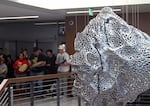Artist Garrick Imatani and the Confederates Tribes of Grand Ronde recently premiered a work of art four years in the making, inspired by one of the most unique spiritual entities in Pacific Northwest tribal history: a mass of iron and nickel the size of a large SUV, that hurtled out of the sky, carried by floods to the Willamette Valley. For millennia, the Clackamas people held an awareness of the meteorite, which they called Tomanowos.
“It was seen as this visitor, this kind of traveler that came from space,” said Travis Stewart (Chinook, Rogue River, Kalapuya), the interpretive coordinator at Chachalu Museum and Cultural Center at Grand Ronde. If you heard about it in school, you probably know it as the Willamette Meteorite. But for the Clackamas, Tomanowos held an honored designation as a visitor, in accord with their traditions upholding hospitality.

Artist Garrick Imatani's collaboration with the Confederated Tribes of Grand Ronde led to two remarkable exhibitions exploring Tomanowos, the largest meteorite to make landfall in North America.
April Baer / OPB
Imatani, an associate professor and chair of the Foundation program at Pacific Northwest College of Art, ran across its history during research for a commissioned public art project for the University of Oregon’s Straub Hall.
“This extraterrestrial object, not even of this planet, becomes this container for the very fraught politics of this area of the Northwest," Imatani said.
Strange Cargo
The story of Tomanowos is a long one. The meteorite formed around the same time as the Earth, Stewart said, and while there's no impact crater indicating its exact point of landing, scientists believe it must have touched down in or near present-day Montana. The glacial melt of the Missoula Floods brought it south to the Clackamas people, where it bore witness to thousands of years of pre-contact life.
When white settlers reached Oregon, they too were taken with the meteorite. It changed hands several times, legally and illegally, from a local farmer to Oregon Ironworks to Wall Street baron William E. Dodge. It ultimately landed in the hands of the American Museum of Natural History in New York City, thousands of miles away from the tribes who revered it.
Meanwhile, the Clackamas people signed the Willamette Valley Treaty of 1855 and were relocated to the Confederated Tribes of Grand Ronde Reservation.
It would be more than a hundred years before they’d be in position to reinstate their relationship with Tomanowos.
Getting Reacquainted
As Imatani learned more about the meteorite’s history, he thought about its travels and how it was carted around and put on display with little thought for long-term consequences.
“I just thought that was really fascinating that something doesn’t need to be of this planet to be representative of the ongoing issues around repatriation, cultural rights and the legacy of colonialism,” Imatani said.

Garrick Imatani is an associate professor of Art at Pacific Northwest College of Art.
April Baer / OPB
As an Asian American artist, Imatani was reticent about telling a story so far from his own cultural experience. But he made a request of the tribe to proceed and, after some conversations with Stewart and others at Chachalu, Imatani struck a partnership with the tribes. Accompanying tribal youth on their annual trip to New York to visit Tomanowos, Imatani and the students developed a 3D profile detailed enough to create a model for casting. Hours of research in tribal archives led him to historic photos of Tomanowos in transit at the hands of settlers, sparking ideas that became foundational to Imatani’s project.
A Different Lens
For his commission, Imatani chose to cast a replica of Tomanowos in aluminum, suspended from the ceiling of Straub Hall’s atrium against the backdrop of a vivid mural he created. It's based on a hydrology map of the Willamette River Valley as it would have appeared during the Missoula Floods. The installation was flanked with photos Imatani created with the help of Stewart, the tribes’ cultural adviser Bobby Mercier and others, as quiet rejoinders to the historic photos of Tomanowos swaddled in American flags, as a prop or a bauble for well-to-do Oregonians.
“We hoisted the replica onto the back of [a] pickup truck” and drove it around Grand Ronde, Imatani said. In another, the replica travels in a canoe, back to its ancestral home in the Willamette Valley.

One of a series of photos Garrick Imatani made for "Witness," on view at Chachalu Museum and Cultural Center, shows a truck hauling a foam cast of Tomanowos.
Courtesy of Garrick Imatani
Mercier said the photos were great fun to work on, but also meant a lot as a contribution to tribal history, “when you can be around objects a thousand years old and know, ‘My great-grandparents did the same thing.’”
Several dozen people, including tribal drummers, were invited to attend the debut at Straub, and passersby clustered in the atrium to take in the sight of the installation and hear the music of the drums.
Imatani said he hopes the Straub Hall project will help all Oregonians, especially those like him without tribal connections, to see Tomanowos as something more than an astronomical specimen, but as the entity the tribes have come to know.
Third Time’s The Charm For 'Witness'
After the installation in Eugene opened, the curators from Grand Ronde felt there might be more to do.
Stewart said, as an artist, he appreciated Imatani’s grasp on the organic nature of Chachalu.
“His approach seems very cellular … a living thing,” Stewart said.
Imatani had ideas too, including a growing plan for the tribes' foam replica and a virtual reality film that might bring more dimensions to the project. Several curators, especially Ashley Stull Meyers, loved Imatani's idea, but a string of downturns in Portland's contemporary art scene dashed their hopes. Myers scheduled Imatani for a major exhibition at Marylhurst University's Art Gym. Its closure last summer led the Art Gym's founders to negotiate a rescue plan at Oregon College of Art and Craft, only to see OCAC collapse under fiscal pressure this year.
But Imatani didn’t give up. Continued conversations with Chachalu led Stewart to offer him space and funding at the museum to bring the project to full fruition.
The exhibition “Witness” explores Tomanowos as it’s experienced in Grand Ronde and in New York. Grounded in a huge constructed glacier form, Imatani’s film, “The Drift,” imagines what kind of cataclysmic event might cut through the bureaucracy that prevents the repatriation of some tribal artifacts. It shows Tomanowos levitating from a highly stylized museum environment, amid a natural disaster on par with the Missoula Floods. As Times Square fills with water, the meteorite levitates majestically into the air, its shadow flitting across the Statue of Liberty’s face as it exits the city. Its journey back to Oregon is marked by brief encounters with other tribal objects and artifacts in other museums along the way.

Garrick Imatani created a VR film for "Witness" imagining a journey for Tomanowos back to Oregon.
Courtesy of Garrick Imatani
As long as it’s taken for “Witness” to come to life, it’s really a drop in the bucket compared with the larger history of Tomanowos.
“Our hope is that people will leave with a different perspective on culture and what’s around them,” Stewart said.
Dave Harrelson (Kalapuya), a cultural resources manager at Chachalu, said as the show came together, he found his own feelings about Tomanowos evolving.
“It’s traveled through the solar system and was encased in ice for so long,” Harrelson said, “and then came down here. Maybe it’s intended to come back home some day. Maybe it’s not. There’s this falseness to think it’s our decisions.”
While it’s immensely rewarding to interact with the meteorite and dream of it coming home, he said, it’s just part of the story.
"Witness" is on view at the Chachalu Museum at Grand Ronde through September.
